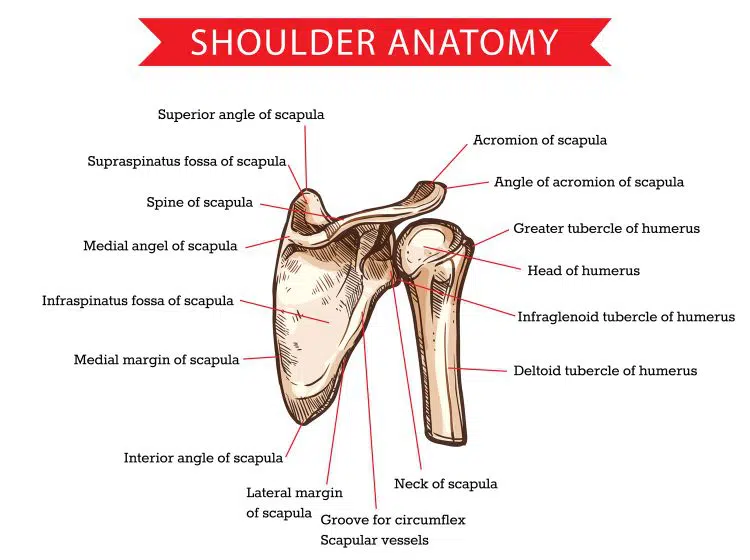Do you want big, round, and broad shoulders that fill out your t-shirt, will earn you praise on the beach, and make you look like Superman? Of course, who doesn’t?
Ask an average lifter about building bigger shoulders; chances are they’ll run circles around pressing movements — the Arnold press, dumbbell shoulder press, military press, or machine press.
However, you need much more than pressing movements to build 3D shoulders. Your shoulders consist of three deltoid heads — the anterior, middle, and posterior.
Overhead presses target the anterior deltoids. Lateral raise movements work the middle deltoids, which help add size to your shoulders and width to your frame.
The dumbbell lateral raise is one of the most popular shoulder exercises that focuses on middle deltoids. The Egyptian lateral raise is a dumbbell lateral raise unilateral variation that better isolates your lateral delts. It requires you to grab a dumbbell in one hand and lean on your working side while holding onto a sturdy surface with the other hand.
In This Exercise:
- Target Muscle Group: Shoulders
- Type: Strength
- Mechanics: Isolation
- Equipment: Dumbbell
- Difficulty: Beginner
- Best Rep Range:
- Hypertrophy: 8-12
- Strength: 1-5
Muscles Worked: Egyptian Lateral Raise
Level Up Your Fitness: Join our 💪 strong community in Fitness Volt Newsletter. Get daily inspiration, expert-backed workouts, nutrition tips, the latest in strength sports, and the support you need to reach your goals. Subscribe for free!
The Egyptian lateral raise is an isolation exercise that targets the lateral deltoids. The medial delts are the biggest shoulder muscle and help move your arm out to the side, as well as up and down.
This unilateral exercise is great for lifters who have trouble establishing a mind-muscle connection with their deltoids in the conventional dumbbell lateral raise. Like other exercises, follow a full range of motion to make the most of this lift.
You could tweak this exercise and target your muscles from different angles by changing the position of your humerus. However, since the exercise setup is relatively complex, ensure you’re in total control throughout the exercise to make the most of this lift.
How To Perform The Egyptian Lateral Raise
This is how to perform the Egyptian lateral raise using the correct form:
- Grab a dumbbell in one hand.
- Stand next to a sturdy column, rack, or cable pulley machine so your other shoulder is facing the horizontal support.
- Place your feet together.
- Grab the support beam at chest height and slowly lean in the opposite direction by extending your support arm.
- At the starting position, the weight-bearing arm should be perpendicular to the floor.
- Pull back your shoulder blades and lift your chest to ensure your traps don’t take over the exercise.
- While maintaining a slight bend in your arm, raise your arm towards the ceiling until it is parallel to the floor.
- Slowly return to the starting position.
- Repeat for recommended reps before switching sides.
Tips to get the best bang for your buck:
- Keep the negatives slow and deliberate for optimal muscle fiber recruitment.
- On the way down, end the movement when the dumbbell (or weight plate) is perpendicular to the floor. Touching the weight to your upper leg at the bottom incentivizes momentum use.
- Maximize shoulder engagement by stopping before the dumbbell returns to the starting position. This puts your target muscles under constant tension.
- Keep your support arm steady throughout the movement. Moving the support arm will take focus away from the target muscle.
Common Mistakes
Many people leave gains on the table by making the following mistakes while performing the Egyptian lateral raise:
1. Going Too Heavy
Most lifters let their ego get the better of them by lifting heavier than they can handle. You know you’re going too heavy if you have to use momentum by jerking your knees to lift the weight.
Since this is an isolation (single-joint) exercise, you should focus on following a full range of motion and contracting your muscles with every rep. Your delts should be filled with blood and lactic acid by the end of each set.
2. Rushing Through Reps
If you are lifting for hypertrophy, you should focus on following the correct form, a full range of motion, and squeezing the life out of your muscles. You cannot achieve optimal target muscle engagement if you dash through reps.
Modify the rep tempo to annihilate your muscles. Follow a (2:1:4:0) rep tempo for optimal muscle fiber recruitment. Spend a couple of seconds on the way up, a second hold at the top, and four seconds on the negative. Do not rest at the bottom.
3. Not Leaning Enough
Some people do not lean to the side enough while performing the Egyptian lateral raise. Fully extending your support arm ensures maximum muscle isolation.
The position of your support arm is critical. Holding the bar too high or low can put unnecessary stress on your support arm, which can cause the assisting arm to fatigue before the working side. Find a comfortable spot and grab the pole firmly to make the most of this exercise.
Benefits of Egyptian Lateral Raise
Adding the Egyptian lateral raise to your training arsenal entails the following benefits:
1. Helps Build Muscle Mass
The Egyptian lateral raise isolates your shoulders, allowing you to build bigger and broader shoulders. Stay in the 8-12 rep range to achieve hypertrophy. [1]
2. Fix Muscle and Strength Imbalances
Working with barbells can make your stronger side stronger and your weaker side weaker. Your stronger side compensates for your weaker side while using a barbell.
Level Up Your Fitness: Join our 💪 strong community in Fitness Volt Newsletter. Get daily inspiration, expert-backed workouts, nutrition tips, the latest in strength sports, and the support you need to reach your goals. Subscribe for free!
Since the Egyptian lateral raise is a unilateral exercise, it helps you focus on one side at a time which can aid in fixing strength and muscle imbalances.
3. Better Mind-Muscle Connection
Training one side at a time helps focus on your target muscles. Lifters who have trouble establishing a mind-muscle connection in the conventional dumbbell side lateral raise should try the Egyptian lateral raise.
4. Keeps Your Ego in Check
Due to its setup, movement pattern, and range of motion, you need to use relatively light weights while performing the Egyptian lateral raise. Going too heavy on this lift hampers your performance and results.
5. A Low-Impact Exercise
As you’ll use a circular movement pattern and a relatively light dumbbell for this exercise, the Egyptian lateral raise won’t be too taxing on your joints, tendons, and ligaments. Follow the correct form and you’ll end this exercise with a muscle-ripping pump without overexerting your joints.
Variations of the Egyptian Lateral Raise
Given below are the Egyptian lateral raise variations that should be a part of your training regimen:
1. Behind-the-Body and Front Egyptian Lateral Raises
The textbook Egyptian lateral raise focuses on your side delts. However, you can achieve better anterior and posterior delt activation by tweaking the exercise movement pattern.
For Better Anterior Delt Engagement:
- Get into the Egyptian lateral raise starting position.
- Instead of holding the dumbbell at your side, place it behind the farthest hamstring.
- Perform a side lateral raise.
- The dumbbell should be at your shoulder height and at your side at the top.
- Slowly return to the starting position.
- Repeat for recommended reps before switching sides.
For Better Posterior Delt Engagement:
In the posterior-focused Egyptian raise variation, hold the dumbbell in front of the quad farthest from the pole at the starting position. Raise the dumbbell to your side until it is parallel to the floor. Focus on contracting the target muscles for optimal muscle fiber engagement.
2. Cable Egyptian Lateral Raise
This exercise is an Egyptian lateral raise variation that helps you maintain constant tension on your delts throughout the movement.
Steps:
- Adjust the cable pulley to its lowest setting and set up a D-handle attachment.
- Get into the Egyptian lateral raise starting position by grabbing onto the cable pulley beam.
- Grab the D-handle attachment with a neutral grip and hold it in front of the quad farthest from the pulley.
- While maintaining a slight bend in your elbow, raise your arm until it is parallel to the floor.
- Return to the starting position with a slow and controlled motion.
- Repeat for recommended reps before switching sides.
Pro Tip: You can put more focus on your anterior delts while performing this exercise by holding the cable behind your back.
3. Incline Bench Dumbbell Lateral Raise
The incline bench dumbbell lateral raise is an incredibly effective exercise to isolate your delts. It eliminates the use of momentum and forces you into following a strict form.
Steps:
- Set an incline bench at a 70-degree angle with the floor. Contrary to what many lifters believe, you don’t need to set the bench at a sub-60-degree angle for this lift.
- Grab a dumbbell in each hand.
- Place your chest against the pad.
- Pull back your shoulder blade and push out your chest.
- While maintaining a slight bend in your elbows, raise your arms to your sides until they are parallel to the floor.
- Slowly return to the starting position.
- Repeat for reps.
Pro Tip: Setting the bench at a 70-80-degree angle focuses on your side delts, whereas 60 and below will move the tension to the posterior delt heads.
4. Dumbbell Lateral Raise
The dumbbell lateral raise is a staple in most shoulder training routines. It helps build wider shoulders and helps achieve the coveted V-taper.
Steps:
- Grab a set of dumbbells and stand straight up with the dumbbells at your sides. Your palms should be facing your body.
- Hold the dumbbells slightly off your body, as this keeps the tension on the side delts. This will be your starting position.
- While keeping your torso stationary and your elbows slightly bent, raise the dumbbells up to around shoulder height.
- Pause at the top of the movement and contract your side delts.
- Slowly lower the weight back to the starting position.
- Repeat for recommended reps.
Pro Tip: Make sure you’re standing upright throughout the movement. You are going too heavy if you have to rock your torso back and forth to achieve the full range of motion.
Check out our complete guide on dumbbell side lateral raise!
FAQs
Is the Egyptian lateral raise more effective than the side lateral raise?
The Egyptian side lateral raise better isolates the medial delts than the conventional dumbbell side lateral raise as the shoulder is under constant tension throughout the motion due to the setup. However, you shouldn’t choose one exercise over the other. Both deserve a place in your training regimen, and you should switch between the two to make the most of your workouts.
Which is the best lateral deltoid exercise?
Each lifter has a different training style, and they might feel their side delts better using different exercises. Without taking anyone’s word for it, you should try different exercises, variations, and splits, until you find what works best for you.
How do I build 3D shoulders?
To build wholesome shoulders, you need to balance your anterior, medial, and posterior shoulder training splits. Over-relying on one can cause strength and muscle imbalances.
Wrapping Up
The Egyptian lateral raise is an underutilized shoulder exercise that helps isolate your side delts. Whether you are a pro or a rookie, this lift should be a part of your exercise arsenal.
To make the most of this lift, use weights that you can control throughout the range of motion and contract your side delts at the top and bottom of each rep.
References
- Schoenfeld BJ, Grgic J, Van Every DW, Plotkin DL. Loading Recommendations for Muscle Strength, Hypertrophy, and Local Endurance: A Re-Examination of the Repetition Continuum. Sports (Basel). 2021 Feb 22;9(2):32. doi: 10.3390/sports9020032. PMID: 33671664; PMCID: PMC7927075.
Interested in measuring your progress? Check out our strength standards for Arnold Press, Shoulder Press, Superman, and more.









